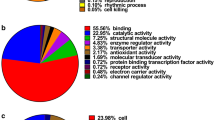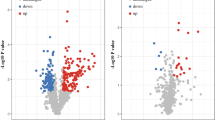Abstract
Metastasis and invasion, the important characteristics of malignant tumors, are closely associated with a series of changes in the expression of genes and proteins. In this study, we compare mRNA and protein expression in high and low metastasis adenoid cystic carcinoma cell lines by mRNA suppression subtractive hybridization and two-dimensional electrophoresis combined with peptide mass fingerprint analysis. 34 differentially expressed genes were obtained using suppression subtractive hybridization experiments including 6 highly expressed gene sequences in the high metastasis cell line, and 28 in the low metastasis cell line. RNA dot blot hybridization further confirmed the results after excluding false positives. For protein analysis, ten significantly different protein spots were detected using two-dimensional gel electrophoresis technique combined with matrix-assisted laser desorption/ionization time-of-flight mass spectrometer (MALDI- TOF-MS). The results then compare with the SWISS PROT database. These results suggest that high tumor metastasis of adenoid cystic carcinoma is associated with multiple genes whose function include angiogenesis, protein synthesis, signal transduction, modulation of cell cycle, molecular chaperones, and immune co-stimulating molecule. Moreover, the results of the phenotypic function-related expression mapping analysis at the mRNA and protein level revealed obvious complementarities, providing important clues for further study of the molecular mechanism of metastasis, metastasis control and possible targets for cancer gene therapy.
Similar content being viewed by others
References
Fang WG (2001) Opportunity and challenge of research of tumor invasion and metastasis in 21st. Chin Medical J, 81(4): 193–194 (Chinese).
Guan X, Qiu W, He R, He RG & Zhou XJ (1997) Selection of adenoid cystic carcinoma cell clone highly metastatic to the lung: an experimental study. International J of Oral & Maxillofacial Surgery, 26: 116–119.
Guan X, Wang Y, Ge S & Li R (1996) The Comparative study on karyotypes of clones from salivary adenoid cystic carcinoma with high and low metastasis. J of China Medical University, 25: 368–370.
Guo J, Tao S, Zhou J, Zhuang J, Xie J & Luo C (2001) Analysis of colon cancer related genes by suppression substractive hybridization. Chines J of Cancer 20 (7): 743–747.
Chu ZL, Mckinsey TA (1997) Suppression of tumor necrosis factor-induced cell death by inhibitor of apoptosis c-IAP2 is under NF-kB control. Proc Natl Acad Sci USA 94: 10057–62.
Fan LC, Yang ST & Gui JF (2001) Differential screening and characterization analysis of the egg envelop glycoprotein ZP3 cDNAs between genogenetic and gonochoristic crucian carp. Cell Research 11: 7–27.
Shi YH, Liu J, Xia JH & Gui JF (2002) Screen for st agespecific expression genes between tail bud stage and heartbeat beginning stage in embryogenesis of gynogenetic silver crucian carp, Yao Hua SHI, Jun LIU, Jian Hong XIA, Jian Fang GUI, Cell Research 12: 133–142.
J.P. Girard, E.S. Baekkevold, T. Yamanaka, G. Haraldsen, P. Brandtzaeg & F. Amalric (1999) Heterogeneity of endothelial cells: the specialized phenotype of human high endothelial venules characterized by suppression subtractive hybridization, Am. J. Pathol 155: 2043–2055.
VonStein OD, Thies WG & Hofmann M (1997) A high throughput screening for transcribed differentially expressed genes. Nucleic Acids Res 25(13): 2598–2602.
Gen WG, Van Kempen LC, Gijzen EG, van Groningen JJ, van Kooyk Y, Bloemers HP & Swart GW (1998) MEMD, a new cell adhension molecule in metastasizing human melanoma cell lines, is identical to ALCAM(activated leukocyte cell adhension molecule, American journal of Pathology 152: 805–13.
Zendman AJ, van Kraats AA, den Hollander AI, Weidle UH, Ruiter DJ & van Muijen GN (2002) Characterization of XAGE-1b, a short major transcript of cancer/testis-associated gene XAGE-1, induced in melanoma metastasis. Int J Cancer. Jan 10; 97: 195–204.
Sharma R, Samantaray S, Shukla NK & Ralhan R (2003) Transcriptional gene expression profile of human esophageal squamous cell carcinoma, Genomics 81 (5): 481–8.
Van der Bruggen, P., Traversari, C., Chomez, P., Lurquin, C., Deplaen, E., Van den Eynde, B., Knuth, A. & Boon, T (1991) A gene encoding an antigen recognized by cytolytic T lymphocytes on a human melanoma. Science, 254 1643–1647.
Boel, P., Wildmann, C., Sensi, M. L., Brasseur, R., Renauld, J., Coulie, P., Boon, T. & van der Bruggen, P. (1995) BAGE: a new gene encoding an antigen recognized by cytolytic T lymphocytes. Immunity, 2: 167–175.
Jacqueline AMV & Reindert JA & Van Moorselaar (1997) Differential expression of ferritin Heavy chain in a rat transitional cell carcinoma progression model, Biochimica et Biophysica Acta 1360: 39–44.
NaiShuo Zhu, JieLin Yang & YingMing Wang et al. (2003) Study of the difference of high and low metastasis cell line’s gene expression map and metastasis-related genes of adenoid cystic carcinoma. Experimental and Molecular Medicine, 35: 243–248.
Hirsch, M. & W. Noske (1998) The tight junction: structure and function. Micron. 24: 325–352.
Pallas, D.C., Fu, H., Haehnel, L.C., Weller, W., Collier, R.J. & Roberts, T.M. (1994) Association of polymavirus middle tumor-antigen with 14-3-3-proteins, Science 265: 535–537.
Hermeking, H., Lengauer, C., Polyak, K., He, T.C., Zhang, L., Thiagalingam, S., Kinzler, K.W. & Vogelstein, B (1997) 14-3-3 sigma is a p53-regulated inhibitor of G2/M progression Mol. Cell 1: 3–11.
Ilse Hofmann, Martina Schno lzer, Isabelle Kaufmann & Werner W. Franke (2002) Symplekin, a Constitutive Protein of Karyo- and Cytoplasmic Particles Involved in mRNA Biogenesis in enopus laevis Oocytes, Molecular Biology of the cell 13: 1665–1676.
Janssen RA, Kim PN, Mier JW & Morrison DK (2003) Over-expression of kinase suppressor of Ras upregulates the high-molecular-weight tropomyosin isoforms in ras-transformed NIH 3T3 fibroblasts. Molecular Cell Biology 23(5): 1786–97.
Bharadwaj S & Prasad GL (2002) Tropomysin-1, a novel suppressor of cellular transformation is downregulated by promoter methylation in cancer cells, Cancer Letter 183(2): 205–13.
Jiang D, Ying W & Lu Y et al (2003) Identification of metastasis-associated proteins by proteomic analysis and functional exploration of interleukin-18 in metastasis, Proteomics 5: 724–37.
Pulaski BA & Ostrand-Rosenberg S (1998) Reduction of established spontaneous mammary carcinoma metastases following immunotherapy with major histocompatibility complex class II and B7.1 cell-based tumor vaccines, Cancer Res. 58: 1486–93.
Author information
Authors and Affiliations
Corresponding author
Rights and permissions
About this article
Cite this article
Yang, Jl., Zhu, Ns., Wang, Y. et al. Protein and mRNA characterization in high and low metastasis adenoid cystic carcinoma cell lines. Mol Biol Rep 31, 241–248 (2005). https://doi.org/10.1007/s11033-005-2712-y
Received:
Accepted:
Issue Date:
DOI: https://doi.org/10.1007/s11033-005-2712-y




